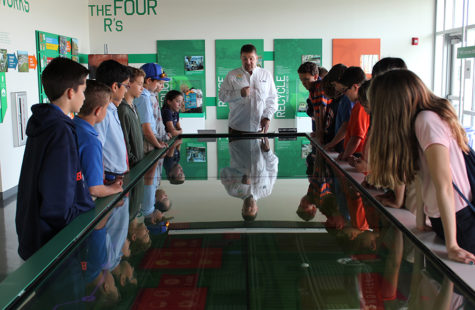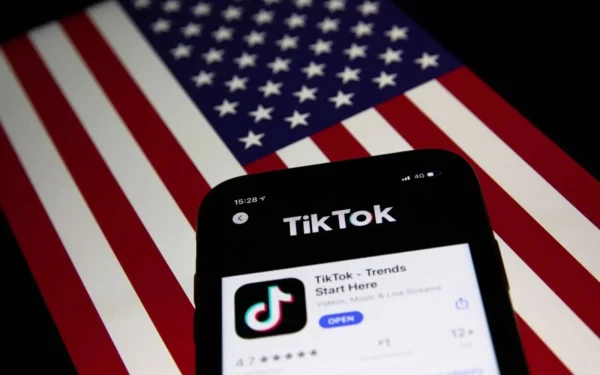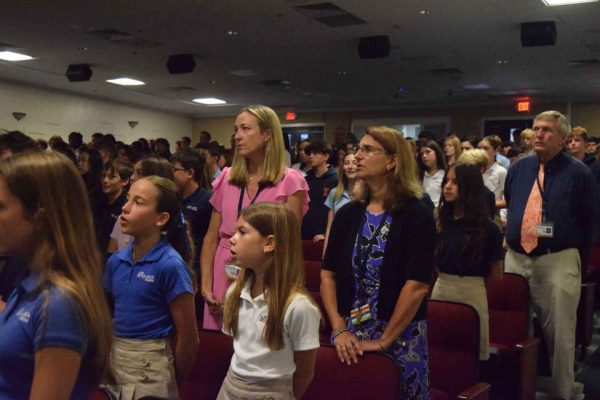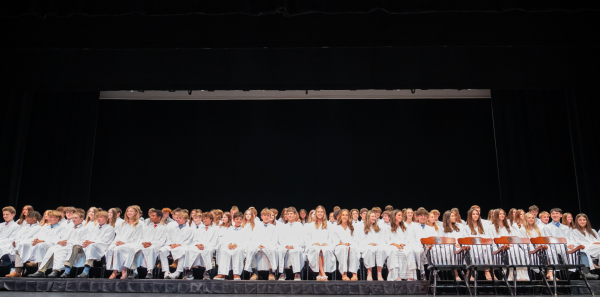Sixth Grade Takes Trip to Solid Waste Authority
Mr. Brian Elkins welcomes the sixth graders to the SWA facility in West Palm Beach.
Trash. Seems like there’s not much to say about it, but actually there is a lot. Most people throw things in the garbage and forget about them. However, The Benjamin School wants to change that. They want their students to be aware of the issues regarding our disposal problems so they can be better informed and help be a part of the solution, not part of the problem.

Mr. Elkins shows the students the various aspects of the Solid Waste Authority property via an interactive table.
As a result, the sixth grade made its annual trip to the Solid Waste Authority (SWA) in West Palm Beach on On March 6. In the weeks prior to the visit, the sixth graders learned all about Palm Beach County’s disposal system and the limited space available for the millions of pounds of trash produced by its citizens. However, the visit to the SWA helped put it all in perspective.
“This trip was fun because we looked at garbage and the way it was processed,” said sixth grader Sophie Marx. The SWA combines recycling, renewable energy, and landfilling to effectively manage the county’s waste. The SWA actually has two facilities – Renewable Energy Facility 1 (REF 1) which was built in 1989 and the newer REF 2 which opened in 2015. Both sites turn the garbage collected from the county’s homes and businesses into electricity.
According to Mr. Brian Elkins, one of the SWA’s educational specialists and the students’ tour guide for the day, “REF 2 reduces the amount of waste going to SWA’s landfill by up to 98 percent.” This ensures that the landfill will last until about 2045. “At the same time,” said Elkins, “the facility generates 100 megawatts of electricity for the people in Palm Beach County.” According the the SWA website, that’s enough electricity to power an estimated 44,000 homes and businesses, or about all the homes in Boca Raton.
The facilities turn the garbage into electricity via boiling. The refuse is divided into burnable and unburnable waste. So the burnable waste is fed into large boilers via conveyors. The boiled garbage produces a tremendous amount of steam which drives a turbine generator to make electricity. The toxins from the boiling are cleaned using benign chemicals, carbon spray, and a lime slurry so those fumes and harmful particles are not released into the air. Any ash or non-burnable material left over is placed in the nearby landfill.
The SWA also has a materials recycling facility, a biosolids processing facility, seven household hazardous waste collection facilities, and a network of six transfer stations. The SWA has been doing its part since 1975 and plan to continue throughout the years.
In addition to the seeing the SWA facilities, the students had the opportunity to “go on nature trails, eat lunch at Dyer Park, which is a capped landfill, [and] get a tour of the education center and recycling center,” said sixth-grade science teacher Mrs. Sukhu. This trip was a big improvement from last year as the students spent a full day on the trip as opposed to a half day.
Inside the SWA facility is a quote in one of the stairwells. It reads, “I speak for the trees, for the trees have no tongues,” which is from The Lorax by Dr. Seuss. It shows that the Solid Waste Authority takes pride in what it does and is focused on a more sustainable future for Palm Beach County. Educating students to join them in their initiative is one more way to make that happen.
Sukhu agrees. “There are people on this earth that create trash each day and have to make choices whether to recycle that or put it in the trash,” she said. “I think it is important for the students to know the consequences of those choices, be better consumers, and make better choices.”





